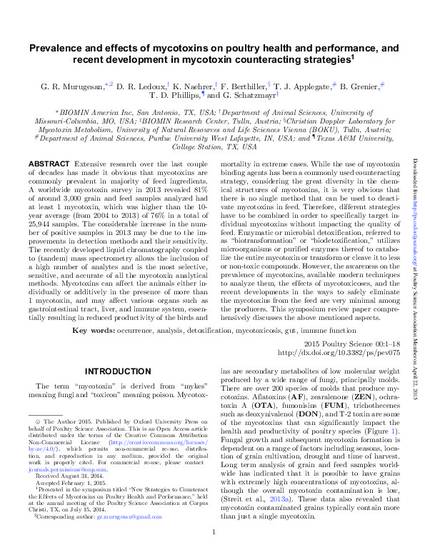
Article
Prevalence and effects of mycotoxins on poultry health and performance, and recent development in mycotoxin counteracting strategies
Poultry Science
(2015)
Abstract
Extensive research over the last couple of decades has made it obvious that mycotoxins are commonly prevalent in majority of feed ingredients. A worldwide mycotoxin survey in 2013 revealed 81 % of around 3,000 grain and feed samples analyzed had at least one mycotoxin which was higher than the ten-year average (from 2004 to 2013) of 76% in a total of 25,944 samples. The considerable increase in the number of positive samples in 2013 may be due to the improvements in detection methods and their sensitivity. The recently developed liquid chromatography coupled to (tandem) mass spectrometry allows the inclusion of a high number of analytes and is the most selective, sensitive and accurate of all the mycotoxin analytical methods. Mycotoxins can affect the animals either individually or additively in the presence of more than one mycotoxin, and may affect various organs such as gastro-intestinal tract, liver and immune system, essentially resulting in reduced productivity of the birds and mortality in extreme cases. While the use of mycotoxin binding agents has been a commonly used counteracting strategy, considering the great diversity in the chemical structures of mycotoxins, it is very obvious that there is no single method that can be used to deactivate mycotoxins in feed. Therefore, different strategies have to be combined in order to specifically target individual mycotoxins without impacting the quality of feed. Enzymatic or microbial detoxification, referred to as “biotransformation” or “biodetoxification” utilizes microorganisms or purified enzymes thereof to catabolize the entire mycotoxin or transform or cleave it to less or non-toxic compounds. However, the awareness on the prevalence of mycotoxins, available modern techniques to analyze them, the effects of mycotoxicoses and the recent developments in the ways to safely eliminate the mycotoxins from the feed are very minimal among the producers. This symposium review paper comprehensively discusses the above mentioned aspects.
Keywords
- occurrence,
- analysis,
- detoxification,
- mycotoxicosis,
- gut,
- immune function
Disciplines
Publication Date
2015
DOI
https://doi.org/10.3382/ps/pev075
Citation Information
G. R. Murugesan, D R Ledoux, K Naehrer, F Berthiller, et al.. "Prevalence and effects of mycotoxins on poultry health and performance, and recent development in mycotoxin counteracting strategies" Poultry Science (2015) Available at: http://works.bepress.com/raj_murugesan/7/
